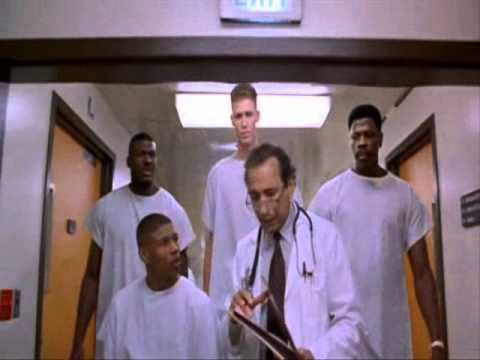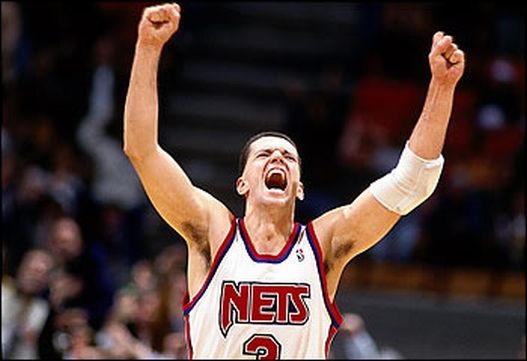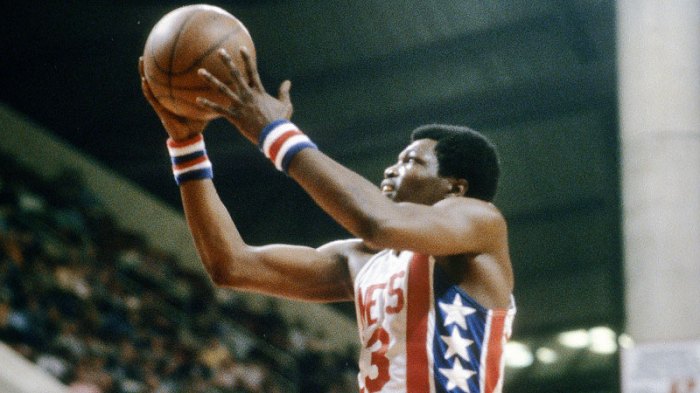
This week in Nets Yearbook, Mark & I rank the franchise’s top power forwards of all-time.
5. Armen Gilliam
Regular Season: 242 G, 3,611 points (14.9), 1,826 rebounds (7.5), 308 assists (1.3), 178 steals (0.7), 203 blocks (0.8), .492 FG%, .000 3P%, .773 FT%, 18.0 PER
Playoffs: 4 G, 42 points (10.5), 25 rebounds (6.3), 1 assist (0.3), 2 steals (0.5), 7 blocks (1.8), .441 FG%, .000 3P%, .750 FT%, 15.0 PER
Mostly a bench player in New Jersey, The Hammer nonetheless played 2 1/2 solid seasons in New Jersey, turning into a full-time starter at the end of the 1994-95 season. An efficient, effective player, Gilliam earned his nickname by playing physical ball each time out on the floor. One of my earliest basketball memories is of Gilliam, though it wasn’t pretty – when I was six, I attended this game, and two things struck me: 1) how easily Shaq handled the Nets quadruple-teams, and 2) how many threes Dennis Scott made. (It was a simpler time.) Gilliam did not exactly stick out (except as fodder for one of Shaq’s many dunks), and when you see the box score, you’ll understand why.
I’m not condemning Armen’s ability, though. He could definitely play. Once given the full-time starting position in 1996, he averaged career highs with 18.3 points and 9.1 rebounds per game. Unfortunately, Gilliam passed away this past summer at the age of 47 playing pick-up basketball in Collier Township, Pennsylvania. -D.K.
4. Jayson Williams
Regular Season: 373 G, 3,084 points (8.3), 3,228 rebounds (8.9), 259 assists (0.7), 175 steals (.5), 275 blocks (.7), .445 FG%, .091 3P%, .601 FT%, 16.1 PER.
Playoffs: 5 G, 22 points (4.4), 45 rebounds (9.0), 5 assists (1.0), 2 steals (0.4), 3 blocks (0.6), .375 FG%, .500 FT%, 12.5 PER.
What’s the best way to talk about Jayson Williams? Despite being a tenacious rebounder, he was never the best player on the floor. Beloved by fans in New Jersey, his infectious personality gave him a “star quality” to general NBA fans. But perhaps no Nets player from the past 20 years has had more trouble away from the court quite like Williams. To this day, I have a hard time wrapping my head around the fact that the one guy with a consistent smile on a team full of malcontents is the one spending his days in prison, having plead guilty to manslaughter for the shooting death of a limousine driver.
Yet Williams’ career in New Jersey was the epitome of Net-dom. A local boy who went to college at St. John’s, Williams embraced playing in the swamp. He only started a handful of games his first few seasons, but finally earned a starting spot in 1996-97 where he alternated between PF and C. Despite playing for a coach he was clearly in conflict with in John Calipari, Williams put up career best numbers during the 1997-98 season, besting Hall of Famer Dennis Rodman for top offensive rebounding rating in the league and making his first and only all-star game that season.
His career abruptly came to an end when he broke his leg in 1999, colliding with Stephon Marbury while going up for a rebound. In his first year of his first big-money contract, and forced to retire and walk away from a fortune. Just another player in a line of “same old Nets.”
More than 10 years after he played his last game, it’s hard to look past his demons and celebrate Williams for anything beyond what he accomplished while playing basketball. However, he was such a joyful, soulful player to watch. He didn’t quite have the competitive fire that a Drazen Petrovic had, but I’m challenged to name a player who loved being in the NBA more than Williams did. While Calipari will tell anyone who listens that Williams’ post-NBA behavior vindicates the coach’s rivalry with his player, as a fan, I’m still inclined to side with the guy who was just so happy to play basketball. Perhaps it was being away from what he loved so much that led to his tragic turn. -M.G.
3. Derrick Coleman
Regular season (per game numbers in parenthesis): 348 G, 6,930 points (19.9), 3,690 rebounds (10.6), 1,093 assists (3.1), 320 steals (0.9), 559 blocks (1.6), .461 FG%, .275 3P%, .770 FT%., 19.8 PER
Playoffs: 13 G, 321 points (24.7), 169 rebounds (13.0), 54 assists (4.2), 15 steals (1.2), 22 blocks (1.7), .479 FG%, .407 3P%, .785 FT%, 22.6 PER
Derrick Coleman is arguably the NBA’s poster boy for arrogance, petulance and willfully unrealized potential — and DC’s greatest sin is likely the last of those traits. He had the talent and the opportunity to go down as one of the NBA’s all-time greats at the PF position, and instead, he happily settled in as a very good player, with infrequent moments of greatness.
Is it unfair of us to condemn DC for what he never amounted to? Just take a look at his stats and his numbers leap out at you– a perennial double-double machine who could score 20 points and grab 10 rebounds in his sleep. A player that finished his Nets career with the third-best PER (player efficiency rating) in the regular season, and the best PER for a Net when it counted the most – the postseason. He was a starter in an all-star game, and a member of the second-ever Dream Team in the Olympics. From a statistical standpoint, not only does DC belong on a list of the Nets best PF of all-time, he belongs on a list of the greatest Nets of all-time.
But as grizzled old sports writers like to remind all us bloggers in our mother’s basements, there’s more to basketball than just numbers. Coleman was a perpetual embarrassment for his words and actions on and off the court – even getting into a racially charged battle with all-time great Karl Malone when he referred to the Mailman as an “Uncle Tom.” DC showed some interest in being a good citizen while playing under Chuck Daly, but was captain of a ship named Mutiny with successor Butch Beard, writing blank checks to the new coach for all the fines he was set on accumulating since he didn’t want to follow any arbitrary rules. By the time he left New Jersey, DC was a bit of a punchline, though that couldn’t match his growing waistline.
I’ve had nights where I’ve gone to sleep and dreamt that Derrick Coleman had the career he should have had with New Jersey. A prolific frontcourt scorer who could dominate the glass, lockdown his opponent defensively and be an ambassador to the game and to Nets basketball for years to come. But these are just dreams. DC would probably laugh at these dreams. Whoop-de-damn-do, right? -M.G.
2. Kenyon Martin
Regular Season: 283 G, 4,269 points (15.9), 2,147 rebounds (7.6), 668 assists (2.4), 361 steals (1.3), 386 blocks (1.4), .467 FG%, .219 3P%, .663 FT%, 15.9 PER
Playoffs: 51 G, 924 points (18.1), 424 rebounds (8.3), 126 assists (2.5), 66 steals (1.3), 70 blocks (1.4), .457 FG%, .125 3P%, .705 FT%, 16.8 PER
“With the first pick in the 2000 NBA Draft, the New Jersey Nets select…” and so it began. Martin is part of the exclusive “I Got Drafted In 2000 And I Matter” club, which meets every Thursday at Mike Miller’s house. Nowadays, they usually just talk about Michael Redd, who was kicked out in 2008.
Seriously though, Kenyon Martin colored my perspective on what a power forward should be. He was arrogant. He was tough. He went out of his way to dunk on people. He ran the floor with Jason Kidd on offense and played tough, in-your-face defense. He gave the proverbial damn. He wasn’t perfect, far from it. Though he’s certainly better than the next year’s alternative – some dude named Kwame – K-Mart is certainly in the bottom half of all-time first overall picks. His arrogance often shaded into the realm of troublesome – most notably in an incident his knees held him back, possibly as the catalyst that forced him to rely on a shaky jumper just a little too much in his four seasons in New Jersey.
I was originally devastated when the Nets “shipped him off” in 2004, in a sign-and-trade that landed them three first-round picks of no consequence. This team had been to the Finals twice with him at the 4, and I firmly believed he was the second-best player on those teams. However, it turned out that Rod pulled a fast one on Denver, as K-Mart never regained that form after multiple knee surgeries. The guy that paid $82.3 million for that trouble? Kiki Vandeweghe. Of course. -D.K.
1. Buck Williams
Regular Season: 635 G, 10,440 points (16.4), 7,576 rebounds (11.9), 976 assists (1.5), 599 steals (0.9), 696 blocks (1.1), .550 FG%, .100 3P%, .649 FT%, 16.7 PER
Playoffs: 21 G, 380 points (18.1), 262 rebounds (12.5), 26 assists (1.2), 27 steals (1.3), 27 blocks (1.3), .547 FG%, .640 FT%, 16.8 PER
Buck Williams gets the top spot almost by default – he’s the team leader in a number of categories, mostly because he’s the team leader in games, games started, and minutes. That’s not to say he didn’t earn this spot. The Rookie of the Year in 1982, Buck led the Nets to the playoffs in his first five seasons with the team.
You’d expect most 21-year-old rookies that average 15-12 on 58% shooting to make some sort of leap, but that wasn’t in the cards for Buck. While he turned in stellar season after stellar season, all of his years in New Jersey seem to blend together: 16-18 points, 12+ rebounds, over 50% shooting. There was no “next step” to his greatness, he just “was” great. The year before joining the team, New Jersey held a defensive rating (points allowed per 100 possessions) of 106.7, 15th out of the 23 teams in the league. In his rookie season? 102.3, good for second in the NBA. That defensive jump helped the Nets increase their win total by 20 games in his rookie season. They floated around that 44-win mark for those five playoff seasons, before nosediving in 1986-87. In 1989, the Nets traded Williams for Sam “Not Jordan” Bowie and a first-round pick (eventually Mookie Blaylock), ending his tenure with New Jersey.
To close: I find it fitting that a guy known for his steadfast consistency from jump street never recorded a usage rate above 20.0%, exactly the league average. -D.K.


















